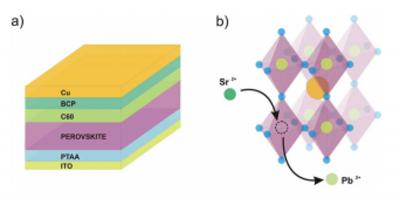Researchers from the University of Potsdam, Humboldt University, Helmholtz-Zentrum Berlin and Technical University Berlin have recently published a paper on perovskite solar cell improvement with the addition of Strontium.
 (a) cell structure in the study (b) perovskite structure used here, indicating how Sr can replace Pb
(a) cell structure in the study (b) perovskite structure used here, indicating how Sr can replace Pb
The team managed to reach record Voc for pin-type perovskite solar cells and elucidated the effect of the Strontium incorporation.
To analyse the effect of Sr addition, the Pb is partially replaced by Sr varying from 0% to 5%. As an electron transporting layer, 30 nm of C60 is deposited on top of the perovskite through thermal evaporation, followed by the top contact constituted by 8 nm of bathocuproine (BCP) and 100 nm of copper (Cu). It has been shown before that C60 does not form an ideal electron selective contact in combination with MAPbI3, and that it mediates significant non-radiative recombination.
The researchers stated that they have recently shown that this device design can yield high efficiencies even with undoped charge transporting layers. For this work, the starting perovskite composition is a quadruple cation perovskite based on the mixture of lead iodide (PbI2) and lead bromide (PbBr2) with four cation salts, namely methylammonium bromide (MABr), formamidinium iodide (FAI), cesium iodide (CsI) and rubidium iodide (RbI).
Finally, a small amount of SrI2 dissolved in DMF : DMSO (4 : 1) was added in different quantities to yield a Sr/Pb ratio of 0%, 0.05%, 0.1%, 0.3%, 0.5%, 1%, 2%, 5% with the goal to study the effect of the Sr insertion from fairly small to considerably high quantities.
The team found that the addition of a small amount of SrI2 to the precursor solution of a hybrid quadruple cation perovskite causes a significant increase of the Voc without the need of any deposition treatment or interlayer deposition. The attained Voc of 1.18 V is among the highest of pin-type perovskite solar cells with a C60 electron-transporting layer for the given bandgap of 1.62 eV. Transient and absolute PL measurements in combination with PES suggests that the addition of Sr causes a drastic reduction of non-radiative recombination at the interface between the perovskite and the C60 electron-transporting layer.
The researchers assign this improvement to a preferential n-doping of the perovskite surface and to the concurrent formation of a space-charge region which, combined with a locally larger band gap at the surface, reduces the access of photogenerated holes to the perovskite surfaces. Adding a thin layer of an insulating polymer on top of the Sr-enriched perovskite surface improved the Voc further to nearly 1.23 V, corresponding to a non-radiative voltage loss of only 110 meV.
This work not only demonstrates very high Voc values and efficiencies in Sr-containing quadruple cation perovskite pin devices, but also highlights the importance of addressing and minimizing the losses located at the interface with the transport layers in working solar cells.